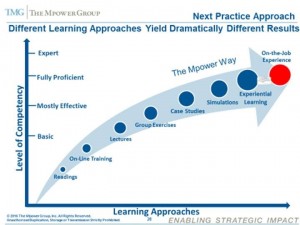Now maybe the thousands of alumni of TMGs’ competency development programs will understand why we always start each and every workshop with a contract between TMG and each attendee that stipulates the responsibility of each attendee if they want to develop competency – APPLICATION or ADOPTION. In a recent NPR story, they lauded the modest increase in scores but in the same story challenged the conclusions because the science tests are composed of multiple choice questions which are essentially focused on recall of terminology or facts. This should sound very familiar to those who have taken the vast array of professional certifications available out there.
“There is no concept at all of where a student might be able to use those facts or have any relevance in anyone’s life, which for me is kind of more meaningful measures of learning.” According to Carl Wieman (a Nobel Laureate ;an advocate for quality active learning: limiting lecture and textbook time in favor of small-group problem solving, with the teacher as coach). While we don’t claim to have Nobel Laureates on our faculty, this approach should sound extremely familiar to all of our alumni 🙂 . We call it experiential learning during the workshop and the Adoption Bridge that must be in place right after the workshop.
A new set of standards called Next Generation Science Standards are being developed to force the issue and get away from learning factoids. Students must be “confronted with a phenomena, asked to develop their own questions, and engage in the practices of science” says David Evans(creator of the standards). The story goes on to point out that testing students on labeling parts of a microscope is a silly waste of time and focus should be on using the it to make discoveries to which I respectfully say – duh! Emphasis should clearly be on evaluating Application and Adoption over time.
This is the major issue we’ve had with all these various certification programs out there. While they look very good for checking off the training box and at a reasonable cost to boot, they add very little in terms of individual or organizational competency. What would you rather have – your entire organization having passed with flying colors all the certification programs out there and extremely good at correctly labeling the various parts of the microscope or making new discoveries everyday? Assuming it’s the latter, then offering up training and certification programs is clearly not effective and not even at a reasonable cost – unless you are willing to ascribe some value to the ability to label a microscope?
The focus has to be in incorporating experiential learning as part of your workshops and then relentlessly focusing on Adoption. That means holding your supervisors accountable so that they can coach and hold their teams accountable for application. The shelf life of all the labels of the different parts of the microscope is measured in weeks – that means that your people will forget everything that you spent all that money on and the training binders will be thrown into the dumpsters at the annual cleaning day. How cost effective was that training?
We have been relentless in adopting this approach for Competency Development with all of our clients and there have been a few times when clients have initially been a bit skeptical – especially when confronted with their role in making sure that competency development occurs. We can only proudly point to our alumni who years after they have “graduated” still remember and are applying what they learnt – we hear that every time we run into them. So please, save your training dollars and throw a big party for your employees if you don’t have an Adoption focus as part of your competency development initiative – you’ll get a better ROI than certifications etc.?



